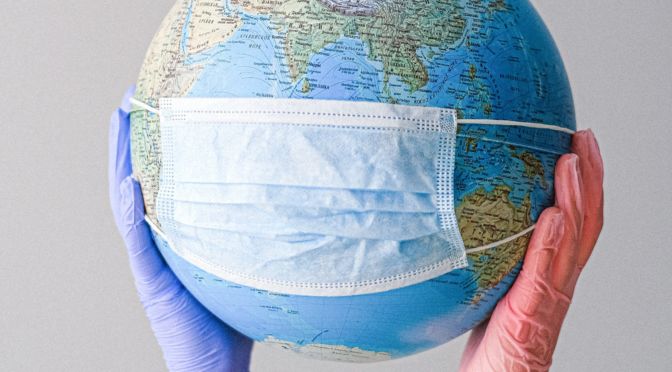By Teboho Letuka
In a world as uncertain as the one we are living in; we look everywhere for news on COVID-19. Perhaps that is how you found yourself reading this blog. In these unprecedented times, it is always better to educate ourselves, learn new things and try as best as possible to cope with the underlying conditions we are faced with. So, for whatever reason you found yourself reading this blog, I hope it will be beneficial. This blog takes a learning and informative approach on how social network analysis (SNA) can be used in analysing COVID-19 in South Africa.
SNA is a method that is used to visualise and analyse various forms of networks using graph theory, more extensively, these graphs are used to investigate social structures (1). The investigation of these social structures draws out the power of networks and the roles individuals or entities play within the network e.g. leadership (2).
SNA has been used to understand the spread of diseases and identify high-risk areas where measures can be put in place to reduce the spread of diseases. Some researchers have used SNA to understand social networks that influence infectious disease transmissions (3). These researchers argue that, “individuals with social ties are more likely to interact with one another and share common household assets, thereby increasing the likelihood of transmitting infectious diseases”(3).
After the 2012 outbreak of the Middle East respiratory syndrome coronavirus (MERS-CoV) in Saudi Arabia, researchers used SNA to identify infected MERS-CoV patients who may have been spreading the disease, they also used it to predict which patients were likely to be infected (4).
Like MERS-CoV, COVID-19 is contracted through close contact with infected individuals, therefore, SNA can be used to examine how social networks may increase the spread of the virus and how it can be used to identify high-risk areas in order to implement interventions and measures appropriate for prevention.
On 5th March 2020, South Africa recorded its first case of COVID-19, a 48-year-old male in KwaZulu-Natal who travelled from Italy (5). To date (20/05/2020), South Africa has recorded 18,003 cases of COVID-19 and 339 deaths (6), the virus has spread throughout the nine provinces. We looked at the first 150 cases to test how SNA could be used to visualise and understand a network. The first 150 cases were reported from 10th March 2020 to 19th March 2020 and included published record of the locations from which the individuals travelled (5). We then explored how SNA could be used to identify high-risk areas in the spread of COVID-19 to guide implementation of interventions and measures for prevention.



The above graphs show the reported travel history of COVID-19 patients from 10th March 2020 until 19th March 2020. We included both visuals to show why SNA better presents COVID-19 than a simple bar graph. Figure 1 presents the SNA output while figure 2 presents a bar graph. As much as the bar graph may look clear, it is deceiving; it appears as if the number of infected individuals is 206 whereas as they are 150. This is because the bar graph does not consider individuals who have travelled to multiple countries.
Whereas SNA, focuses on connections. In SNA, bigger bubbles represent nodes (individuals/entity) with larger connections and smaller bubbles represent nodes with smaller connections while the lines represent edges (connections). In this case, bigger bubbles are countries mostly travelled by COVID-19 patients and smaller bubbles were least travelled and the lines represent travelling. So, for an individual who may have travelled to more than one country, instead of reading the individual as another person, SNA uses lines to form connection between the two countries. Consider person A in figure 1who is reported to have travelled to both the UK and Switzerland, SNA clearly shows the connection that person A has with the two countries and how people in either country may have been at risk of contracting the disease if they were ever in contact with such a person. Such in-depth detail could not be drawn from the bar graph (figure 2).
In figure 1 the UK and Italy are presented to have the highest connections to COVID-19 patients in SA i.e. majority of COVID-19 patients in SA had travelled to the UK and Italy, with the UK being the most travelled to. This is not surprising as Europe has become the epicentre of the virus surpassing China with the number of COVID-19 cases recorded. To date the UK has over 248,000 COVID-19 cases and has recorded over 35,704 deaths whereas Italy has over 227,000 COVID-19 cases and recorded over 32,330 deaths. Also, among the most travelled countries were the US, Switzerland, Austria, France, Dubai, Netherlands, and Germany.
Figure 1 also validates what has been explained by Professor Salim Abdool Karim on the three waves of the SA epidemic (7). In his presentation, wave 1 of the virus would be from travellers-this is depicted by figure 1 which shows where most of the SA COVID-19 cases were from. The need for a travel ban was essential to curb the spread of the virus into SA. On 15th March 2020, SA went into stage 2: primary prevention of its COVID-19 response. President Cyril Ramaphosa introduced an international travel ban (8).
Wave 2 of the virus would be through contacts and nosocomial transmissions, figure 1 shows high connections locally; these are COVID-19 patients that have no record of international travel. This brings to attention an increase in local transmissions. As a measure to curb international transmission of the virus, travel bans were imposed, but how does a country implement measures to reduce the spread of COVID-19 in its own boundaries? A travel ban within SA would need to be imposed. On 26th March 2020 SA moved to stage 3: lockdown of its response. A nationwide lockdown was imposed as a measure of reducing local transmissions and flattening the curve.
With a rise in local transmission, SA would be seen to experience wave 3 of the pandemic-community transmission and experience an exponential growth in the pandemic. However, SA’s epidemic trajectory seemed very unique as community transmission became low and cases declined (7). This instigated questions like, “are we missing cases due to low or declining testing coverage?”(7) The lockdown bought SA some time and prepared them to go into stage 4: surveillance and active case-finding. Without individual-level data, it is hard to determine how the COVID-19 network has changed over time in SA, specifically on community transmissions. The availability of such data would help guide decision-makers in preparing for stage 5: identifying of hotspots.
SNA if applied at local or community levels may be useful in determining where to focus tracer efforts. Lower level SNA will show us where there are hubs (areas with most COVID-19 cases) if we see a hub growing then efforts should be focused there to increase testing and other health resources e.g. spotting that a church is a focal attribute of a group of nodes (majority of COVID-19 cases in the Free State were linked to a church services (9)).
Our lessons in using SNA to visualize the COVID-19 network may provide useful insights into an approach which can be added to the toolbox of many helpful visualizations of this disease (also see other viz).


